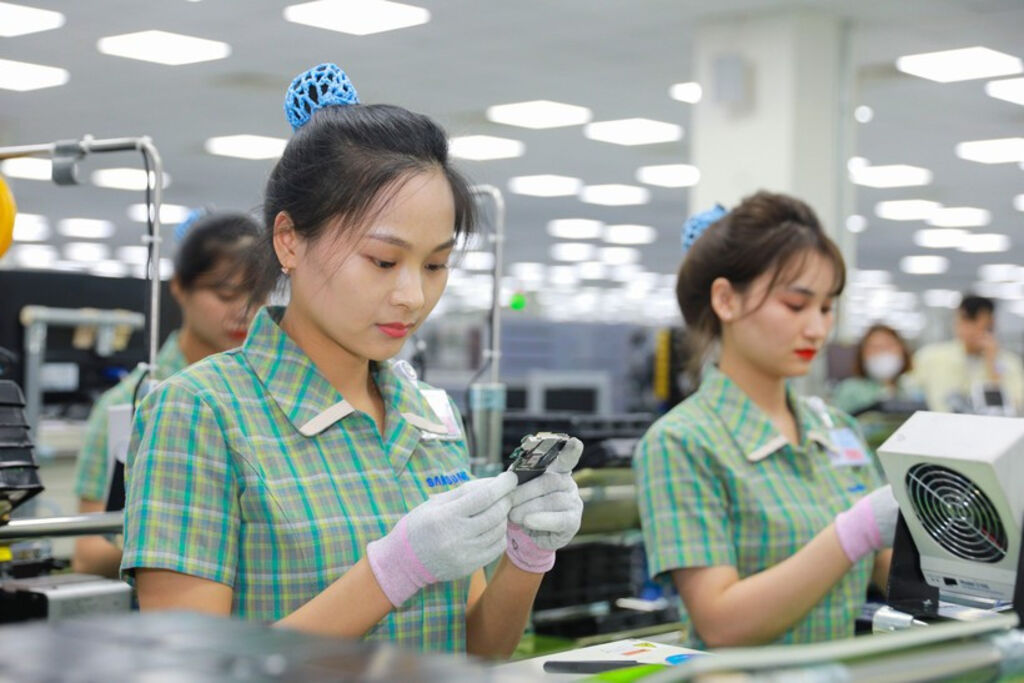 |
| Vietnam records over USD 24.1 billion in registered FDI capital in the first seven months of 2025, a 27.3-percent year-on-year increase__Photo: VNA |
Despite being affected by the US’s tariff policy, Vietnam continues to stand out as an attractive destination for foreign direct investment (FDI), particularly over the medium and long term, analysts held.
Do tariffs impact FDI into Vietnam?
A recurring question is whether US tariff measures are dampening FDI into Vietnam. Figures from the Foreign Investment Agency (FIA) under the Ministry of Finance suggest otherwise. Vietnam recorded over USD 24.1 billion in registered capital in the first seven months of 2025, a 27.3 percent year-on-year increase, and USD 13.6 billion in disbursed capital, up 8.4 percent.
FDI inflows into Vietnam remain highly positive despite external headwinds, affirmed Minister of Finance Nguyen Van Thang. He underlined Vietnam’s targeted FDI strategy, political stability, favorable investment environment, and strong positioning.
Nonetheless, some impact is inevitable. The US has imposed reciprocal tariffs on many countries, including Vietnam. Vietnamese exports now face a 20 percent tariff, compared to 19 percent for Thailand, Indonesia, and Malaysia; 15 percent for the Republic of Korea (RoK) and Japan; and 25 percent for India.
In today’s global context, geopolitical and policy-related risks remain, the FIA warned, adding that the US imposition of a 20 percent reciprocal tariff on certain Vietnamese exports continues to pose risks to FDI inflows and bilateral trade.
While overall FDI remains strong, there are signs of strain. Large-scale, high-tech projects have become less frequent, and newly registered capital has shown limited improvement. In July, there were 266 new projects with total registered capital of 743.9 million USD, down 67.3 percent from June. Over the first seven months of the year, new registrations totaled over USD 10 billion, an 11.1 percent year-on-year decrease.
The FIA noted that the current 20 percent tariff, far lower than the previously proposed 46 percent, is considered a “softened measure” that helps mitigate wider impacts and maintain investor confidence.
Vietnam’s investment appeal
In a time of global uncertainty and increasing competition for FDI, Vietnam remains a leading destination. Vietcombank Securities (VCBS) analysts recently highlighted that Vietnam’s reciprocal tariff is still lower than that of Brunei and India (25 percent), and only slightly higher than regional peers such as Thailand, Cambodia, Indonesia, and Malaysia (19 percent).
Vietnam possesses clear competitive advantages in production and FDI attraction, VCBS asserted, underlining that the country is expected to continue positioning itself as a key player in global supply chains.
VCBS analysts showed concern over risks linked to tariffs on transshipped goods. In its recent review of the EU–Vietnam Free Trade Agreement (EVFTA), the European Chamber of Commerce in Vietnam (EuroCham) flagged ambiguity around the US definition of “transshipped goods”, which may affect trade flows and investment.
Boosting localization and ensuring transparency in supply chains are seen as critical steps in reducing both trade and investment-related risks.
According to the FIA, major investment funds such as Dragon Capital and VinaCapital view the 20 percent tariff as “predictable and acceptable”, and not likely to alter medium- or long-term trends.
Some FDI enterprises are using this as an opportunity to expand operations in Vietnam, raise localization rates, and meet origin requirements to mitigate future tariff risks, the agency noted. This trend supports Vietnam’s selective FDI approach, which targets high-tech, value-added, and sustainable industries.
Despite existing risks, Vietnam is still seen as a secure and appealing investment destination. A recent reform is expected to further strengthen this perception - from July 1, 2025, Vietnam officially implemented a two-tier local government model, designed to clarify responsibilities across government levels and improve policy responsiveness and administrative efficiency.
This structural reform is anticipated to enhance governance and increase confidence among foreign investors amid a volatile global landscape, the FIA leader stated.
Diplomatic initiatives are also reinforcing FDI momentum. During a recent state visit to the RoK by Party General Secretary To Lam, both nations issued a Joint Statement to deepen the Comprehensive Strategic Partnership between the two countries, with investment cooperation identified as a key area.
Vietnam and the RoK committed to encouraging Korean enterprises to increase their presence in Vietnam, especially in priority sectors such as high-tech industrial parks, AI, semiconductors, infrastructure, renewable energy, smart cities, and global value chains.
This collaboration is expected to accelerate Korean investment into Vietnam’s strategic industries and further strengthen Vietnam’s overall FDI trajectory.- (VNA/VLLF)









